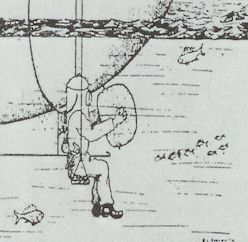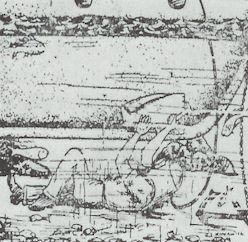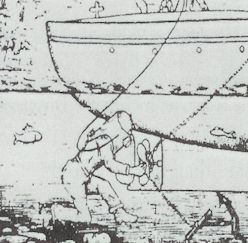


In the 1927 catalog, Miller Dunn explained how easy it is to use the helmet to work on rudders, propellors and even to lie down.
Introduction
Probably the most famous of all shallow water helmets. They were produced by the Miller Dunn Company from Miami Florida. These helmets were used by the Navy and by civilians for many years. Miller Dunn is no longer in business but their helmets live on and are still in use for pleasure within Working Equipment Groups.
Style one
The first Miller Dunn helmet came on the market in 1916. It is made of sheet copper with brass fittings and a 6" round faceplate. Four external lead weights are needed to submerge and balance the helmet. They are held in place by two copper stips on front and rear, bolts and wingnuts. Miller Dunn introduced the name DIVINHOOD. A diving apparatus so simple anyone can use it!
|
|
|
|
|
In the 1927 catalog, Miller Dunn explained how easy it is to use the helmet to work on rudders, propellors and even to lie down. |
||
|
|
|
Miller Dunn style one
helmet with recasted weights. |
|
|
|
|
Miller Dunn style one shallow water helmet from around 1916. The weights are missing. |
|
|
Dunn
Divinghood Co. |
|
Some helmets
had the name and patent stamped in on both sides. |
|
Style two
Around 1927, Miller Dunn
introduced the second style shallow water diving helmet. The helmet of 17 ounce,
hradrolled copper is cylindrical in shape, domed on top, and made with a roled
edge at the bottom to conform with and fit comfortably over the diver's
shoulders, upper chest and back. The unweighted helmet weighs 26.5 pounds, but
when properly weighted, it weighs 60 punds. A handle is rivited to the top of
the helmet to facilitate handling.
The front of the helmet is fitted with a heavy bronze frame in which two
plate-glass windows are located. The windows are made watertight by being set in
soft wicking with white lead, and are secured by right- and lefthanded securing
frames and held to the helmet by 19 hexagonal headed stud bolts. Each window is
10 by 5 inches, and either glass may be removed for replacement without
disturbing the other. A long-top short-bottom guard protects the glass from
breakage.
A male threaded air inlet connection, termed the gooseneck, is rivited and
sweated to the right side of the helmet near the bottom and is curved downwards
towards the rear at a 35 degree angle so as to give a fair lead to the air hose.
An eye is formed on the curve of the gooseneck for securing the bight of the air
hose.
A copper baffle plate sweated
over the air inlet inside the helmet deflects the air upon entrance, causing it
to pass over the faceplate and thus prevents its fogging. Small holes pierced in
the bottom of the helmet permit the escape of excess air in addition to that
which escapes around the shoulders. Broad copper straps are rivited to the front
and back plates of the brass clips molded in the lead weights.
Four 8.25 pound lead weights are hung on the weight straps of the helmet, two in
front and two in the back, to prevent the helmet from lifting off the diver's
shoulders. They are secured to the helmet by marline stops, passed through holes
provided in the weights.
Style two was adopted by the US Navy as their official shallow water diving helmet.
Style two prototype
Miller Dunn experimented with one piece wrap around faceplates. This produced distorted vision and the helmet never made it into production
|
|
|
|
Photo courtesy of Atlantic Diving |
|
Style three
In 1940, Miller Dunn introduced style three. Continuous research had resulted in important improvements. Style three has four windows for great visibility and only two weights. The top part now followed the shape of the diver's head, making it easier to tilt the head backwards for an upward view and freedom from draft from the air inlet. The shouder fit was further improved by a contour roll that also added strength to the bottom part. Air enters the Divinhood on the lower side and is guided by a deflector to the front window. Fogging and draft have been reduced to a minimum. The position of the air inlet forms an air safety chamber, in case of a cut or loosened hose.
|
|
|
|
|
|
Born in 1940 and still in great shape |
|||
|
|
|
Style three helmet. Missing weights. Photo courtesy of Leon Lyons |
| From left to right: Miller Dunn style three divinhood, Miller Dunn 2 cylinder "wobbler" diving pump, Miller Dunn Style two shallow water helmet. Photo courtesy of Robert Croot. |
|
|
|
|
|
One for the road. This beauty shines like a new one. Photo courtesy of our friend Barry Bock |
|
|
|
DIVINHOOD
STYLE 3 Navy
Standard Miller-Dunn
Co. |
Continue to part 2 of the Miller Dunn shallow water diving helmet section